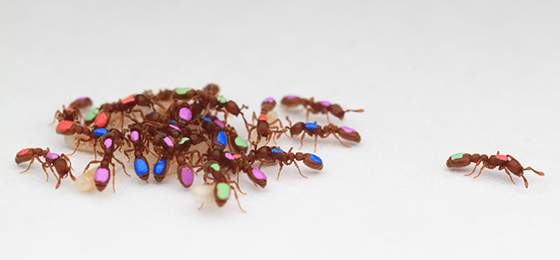The complex organisation of an ant colony

A study on predatory ants, supported by the Swiss National Science Foundation, explains how small differences between individuals can change the collective organisation of the colony.
The colonies of social insects are complex systems that are entirely self-organised. Scientists who looked at the demographic, genetic and morphological structure of ant colonies were able to show how this self-organisation works in practice. The study was supported by the Swiss National Science Foundation (SNSF) and is the subject of a paper published in PLOS Biology (*).
Colonies of clonal raider ants (Ooceraea biroi) were used as model organisms in this study. This Asian predatory ant is interesting for researchers because they can easily control the age, genetic and morphological makeup of colonies.
In their study, they have shown that the organisation in a homogeneous colony is modified when different individuals are introduced. "Individuals of different sizes increased the division of labour in the colony, while genetically different individuals reduced it," explains Yuko Ulrich, the study's first author and former researcher at the University of Lausanne. "In fact, each source of heterogeneity generates a distinct pattern of behavioural organisation in the colony," she says.
Who will do the dishes?
The results have surprised scientists because they go against some current theories on social groups. "It is thought that individuals act according to their tolerance threshold to stimuli," says Yuko Ulrich. To illustrate this model, the scientist proposes a comparison with humans: "In a family, some individuals react much more quickly than others to a pile of dirty dishes. They will therefore find themselves doing the dishes more often: a division of labour is taking place."
To explain the results of their ant study, the researchers had to expand this theoretical model. It now takes into account not only the stimulus tolerance but also the efficiency of each individual in performing a task and the overall workload of the colony.
This model still needs to be tested, but it is already opening up possibilities, explains Yuko Ulrich. It could provide a better understanding of other complex biological systems in which large numbers of heterogeneous individuals interact; this in turn could be used to generate more accurate predictions of collective outcomes.
Automatic tracking of individuals
The scientists carried out their tests on 120 colonies of ants, homogeneous or heterogeneous, which they raised in transparent Petri dishes. In order to observe the behaviour of each ant, they developed an automatic tracking system. "This is the first time such a system has been implemented on this scale in an ant study. Without this type of software, tracking would have been impossible," explains Yuko Ulrich. Each experiment lasted about a month. About 7000 images were taken for each colony.
In order to be identified by the software, each ant was marked with a unique colour combination. Based on the spatial distribution of each individual, the software calculated an index of the division of labour in each colony. It does not specify what each individual does, but it gives clues to their role. "If an ant often stays near the nest, we can assume that it is caring for the larvae. An ant that moves around a lot is more likely to be in charge of foraging," explains the scientist.
(*) Y. Ulrich, M. Kawakatsu, C. K. Tokita, J. Saragosti, V. Chandra, C. E. Tarnita, D. J. C. Kronauer: Response thresholds alone cannot explain empirical patterns of division of labor in social insects, PLOS Biology (2021).
Promoting the independence of young researchers
This study was supported by the Ambizione funding scheme of the SNSF. These grants are intended to support young researchers who wish to carry out a project of their own at a university or research institution in Switzerland. The duration of the funding is four years.